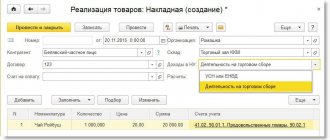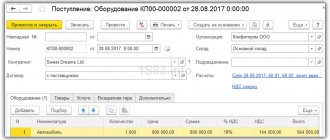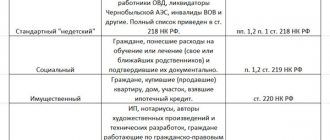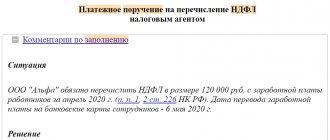Order of the Federal Tax Service of Russia dated May 30, 2007 No. MM-3-06/333 approved the so-called Concept of a planning system for on-site tax audits. It allows you to understand to what extent your business is at risk of being subject to an on-site audit by tax authorities. One of the main criteria for this is profitability by type of activity. In mid-May 2021, the Russian Tax Service published fresh indicators of safe profitability by type of economic activity for 2021. We provide a complete list of them in this review (can be downloaded) so that each company (IP) can compare them with its value.
What types of activities are included?
Appendix No. 4 to the said order traditionally establishes the profitability of ordinary activities. Now - for 2021 (updated every year). Ask why only ordinary ones? The fact is that, purely physically, tax authorities are not able to cover all types of activities mentioned in OKVED-2.
Also, tax authorities, of course, are primarily interested in the profitability of the main activity as a criterion for inclusion in the field department’s plan.
Also see “On-site tax audit period: what they will come to see.”
Calculation formulas for different types of taxation
The tax office calculates the burden for each enterprise separately, depending on the type of taxation and type of taxes. Let us consider in more detail the calculation methods for each particular case.
For organizations on OSNO
Tax burden = (Amount of VAT payable to the budget + Amount of income tax calculated for payment) ÷ Revenue × 100, where:
- the VAT amount is taken from line 40, section 1 of the VAT return;
- tax amount - from line 180, sheet 2 of the income statement;
- revenue - from line 2110 of the financial statements.
For individual entrepreneurs on OSNO
Tax burden = personal income tax ÷ Total amount of taxable income × 100, where:
- Personal income tax is taken from line 40, section 1 of the 3-NDFL declaration;
- the amount of income is from line 60, section 2 of the 3-NDFL declaration.
For individual entrepreneurs and organizations on the simplified tax system
Tax burden = Amount of tax transferred ÷ Amount of income received × 100, where:
- the tax amount is taken from line 133, sections 2.1.1, 2.1.2 and pages 273, 280, section 2.2 of the simplified taxation system declaration;
- the amount of income - from line 113, sections 2.1.1, 2.1.2 and page 213, section 2.2 of the simplified taxation system declaration.
For individual entrepreneurs and organizations on the Unified Agricultural Tax
Tax burden = Amount of calculated tax ÷ Amount of income received × 100, where:
- the tax amount is taken from line 50, section 2 of the Unified Agricultural Tax declaration;
- the amount of income is taken from line 10, section 2 of the Unified Agricultural Tax declaration.
If an enterprise has obligations to pay transport, water and land taxes, excise taxes, mineral extraction tax, and use of resources, then these are also included in the calculation.
VAT burden
For companies using this type of tax, the fiscal service also calculates the share of deductions using the following formula:
Share of deductions = Total amount of deductions ÷ Total amount of accrued VAT × 100%, where:
- the amount of deductions is taken from line 190, section 3 of the VAT return;
- the VAT amount is from line 118, section 3 of the VAT return.
If the result of the calculations is more than 89%, then the enterprise will be classified as a risk group, so before each submission of a declaration it is worth checking the proportion of VAT deductions. In case of excess, it is better to transfer part of the deductions to the future or leave them as they are and prepare answers to questions from tax authorities and supporting documents.
Personal income tax burden
The calculation of the tax burden for personal income tax is determined by the formula:
Tax burden for personal income tax = Calculated personal income tax ÷ Total amount of income from this activity × 100%.
The tax office will require an explanation if the resulting value is too low. For legal entities, an important indicator here will be the dynamics of payments; the Federal Tax Service will pay close attention to the company if:
- Personal income tax amounts decreased relative to previous periods by more than 10% based on the results of the quarter or year.
- Based on the amount of personal income tax, it was revealed that the company pays wages below the regional average.
The amounts of insurance premiums are also reviewed to see if they have decreased with the same number of employees.
Types of indicators
Note that profitability indicators by type of activity in the Concept of on-site inspections of the Federal Tax Service are always presented in tabular form. And there are 2 types of them:
- return on assets indicators by type of economic activity;
- indicators of profitability of sales by type of activity - goods/products/works/services.
Please note that safe profitability by type of economic activity for 2021 is shown as a percentage.
Return on sales is the ratio of the balanced financial result (profit minus loss) from the sale of goods (products, works, services) to the cost of goods sold (products, works, services), taking into account commercial and administrative expenses.
If a loss is received, there is a loss. Return on assets is the ratio of the balanced financial result (profit minus loss) to the value of the company's assets. If it is negative, there is a loss.
Below is a complete official list of profitability indicators by type of activity for 2021 for 2021.
| Type of economic activity (according to OKVED-2) | Period 2021 | |
| Profitability of goods/products/work/services sold, % | Return on assets, % | |
| Total | 7,5 | 5,3 |
| agriculture, forestry, hunting, fishing and fish farming | 17,3 | 6,4 |
| crop and livestock farming, hunting and provision of related services in these areas | 14,5 | 5,0 |
| forestry and logging | 5,4 | neg. |
| fishing and fish farming | 49,9 | 22,7 |
| mining | 25,9 | 11,0 |
| coal mining | 30,6 | 16,5 |
| production of crude oil and natural gas | 25,2 | 11,1 |
| metal ore mining | 50,3 | 15,6 |
| mining of other minerals | 42,8 | 8,2 |
| manufacturing industries | 11,5 | 5,5 |
| food production | 8,4 | 7,0 |
| beverage production | 12,4 | 5,9 |
| tobacco production | 24,6 | 10,3 |
| textile production | 8,7 | 4,0 |
| manufacture of wearing apparel | 13,3 | 12,7 |
| production of leather and leather products | 10,9 | 4,7 |
| wood processing and production of wood and cork products, except furniture, production of straw products and wicker materials | 8,4 | 2,1 |
| production of paper and paper products | 20,5 | 13,2 |
| printing and copying activities | 8,7 | 6,5 |
| production of coke and petroleum products | 8,3 | 3,9 |
| production of chemicals and chemical products | 19,8 | 8,6 |
| production of medicines and materials used for medical purposes | 28,9 | 10,5 |
| production of rubber and plastic products | 9,1 | 7,0 |
| production of other non-metallic mineral products | 10,0 | 3,0 |
| metallurgical production | 20,7 | 12,5 |
| production of finished metal products, except machinery and equipment | 10,7 | 4,2 |
| production of machinery and equipment not included in other categories | 7,8 | neg. |
| production of computers, electronic and optical products | 16,3 | 7,1 |
| production of electrical equipment, | 8,3 | 6,9 |
| production of motor vehicles, trailers and semi-trailers | 3,2 | neg. |
| production of other vehicles and equipment | 12,9 | 1,9 |
| production of other finished products | 6,4 | neg. |
| provision of electrical energy, gas and steam; air conditioning | 8,3 | 4,1 |
| generation, transmission and distribution of electricity | 11,7 | 4,8 |
| production and distribution of gaseous fuels | 2,8 | 2,1 |
| production, transmission and distribution of steam and hot water; air conditioning | neg. | neg. |
| water supply; water disposal, organization of waste collection and disposal, pollution control activities | 3,6 | 1,3 |
| construction | 7,2 | 1,8 |
| wholesale and retail trade; repair of vehicles and motorcycles | 4,6 | 4,8 |
| Wholesale and retail trade in motor vehicles and motorcycles and their repair | 2,1 | 4,1 |
| wholesale trade, except wholesale trade of motor vehicles and motorcycles | 6,1 | 4,4 |
| retail trade, except trade in motor vehicles and motorcycles | 2,3 | 7,5 |
| activities of hotels and catering establishments | 7,0 | 3,3 |
| transportation and storage | 9,7 | 4,7 |
| railway transport activities: intercity and international passenger transportation | 8,3 | 1,1 |
| railway transport activities: freight transportation | 15,2 | 15,8 |
| activities of other land passenger transport | neg. | neg. |
| activities of road freight transport and transportation services | 4,0 | 4,4 |
| pipeline transport activities | 13,5 | 5,5 |
| water transport activities | 3,5 | 3,3 |
| air and space transport activities | 1,8 | 8,5 |
| postal and courier activities | 5,4 | 1,1 |
| information and communication activities | 14,2 | 9,1 |
| financial and insurance activities | 0,4 | 2,1 |
| real estate activities | 15,5 | 2,2 |
| research and development | 15,9 | 3,9 |
| public administration and military security; social Security | 1,6 | 1,4 |
| education | 5,0 | 3,0 |
| health and social services activities | 10,4 | 6,3 |
| activities in the field of culture, sports, leisure and entertainment | 1,2 | 0,2 |
Source of information on safe profitability by type of economic activity for 2021: official website of the Federal Tax Service of Russia.
You can download profitability indicators of organizations by type of economic activity for 2021 for free from our website using a direct link here.
Read also
17.05.2018
What documents define the concept of tax burden?
The main documents defining the concept of “tax burden” in relation to the relationship between the taxpayer and the tax authorities are:
- Order of the Federal Tax Service of Russia “On approval of the Concept of the planning system for on-site tax audits” dated May 30, 2007 No. ММ-3-06/ [email protected] According to the changes made to this document by the order of the Federal Tax Service of Russia dated May 10, 2012 No. ММВ-7-2/ [ email protected] , its Appendix No. 3, reflecting the indicators of the total tax burden for sectors of the national economy and the country as a whole, is updated annually with data for the past year no later than May 5. These data can also be seen on the Federal Tax Service website (https://www.nalog.ru/rn77/taxation/reference_work/conception_vnp/).
- Until July 25, 2017 – letter of the Federal Tax Service of Russia “On the work of tax authorities’ commissions on the legalization of the tax base” dated July 17, 2013 No. AS-4-2/12722, which contained formulas for calculating the tax burden in relation to some specific taxes and certain types of tax regimes. Its effect was canceled step by step (by letters of the Federal Tax Service dated 03/21/2017 No. ED-4-15/ [email protected] and dated 07/25/2017 No. ED-4-15/ [email protected] ).
- From 07/25/2017 – letter of the Federal Tax Service of Russia “On the work of the commission for the legalization of the tax base and the base for insurance premiums” dated 07/25/2017 No. ED-4-15 / [email protected] , regulating the work procedure of the relevant commissions conducting analysis during this work dynamics of those indicators of taxpayers’ economic activity, on which the level of their tax burden depends. Formulas for calculating the tax burden, similar to those contained in letter No. AS-4-2/12722, are also given here (in Appendix 7). In comparison with letter No. AS-4-2/12722, provisions have been added to letter No. ED-4-15/ [email protected] regarding the analysis of data received in connection with reporting on insurance premiums submitted to the Federal Tax Service from 2021.
The very names of these documents indicate the high importance of the indicator under consideration not only for the Federal Tax Service, but also for taxpayers. In order No. MM-3-06/ [email protected] in the list of criteria by which taxpayers are selected for audit, the tax burden is in 1st place, and in letters No. AS-4-2/12722 and No. ED-4 -15/ [email protected] it is not only given a significant part of the text, but also its meanings are given (letter No. AS-4-2/12722) or comparative indicators (letter No. ED-4-15/ [email protected] ), which may cause close attention to the activities of a legal entity or individual entrepreneur.
For information on how an on-site audit is carried out, read the article “Procedure for conducting an on-site tax audit (nuances)” .
Load for a specific tax
Most often, the tax burden is calculated using VAT and income tax.
Level of income tax burden
The Federal Tax Service will be alert if it is below the following indicators:
- for trade enterprises – less than 1%;
- for other organizations, including those involved in production and contracting - less than 3%.
It is calculated using the following formula:
ННп = Нп / (Др + Двн),
where: ННп – tax burden for income tax; Np – income tax based on the results of the annual declaration; Др – income from sales, determined according to the profit declaration data; Dvn – other (non-operating) income of the organization according to the same declaration. The result obtained is multiplied by 100%.
Level of tax burden for VAT
The Federal Tax Service recognizes the level of tax burden for VAT as low if for all four quarters of the reporting year the amount of tax deductions for VAT amounts to 89% or more of the total amount of this tax.
There are several ways to calculate the VAT burden.
- Divide the amount of VAT (VAT) paid into the tax base indicators in accordance with Section 3 of the relevant declaration, based on the state of the Russian market (NBRF):
NN for VAT = NNDS / NBRF
Find the ratio of the amount of VAT according to the declaration (VAT) to the total tax base, which includes both indicators of the Russian market and the export market (NBtotal):
NN for VAT = NNDS / Nbot.






